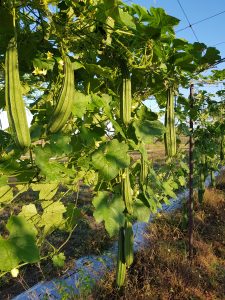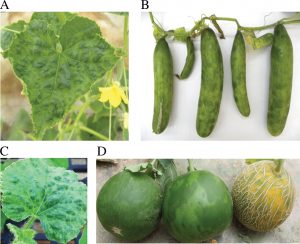Understanding and managing cucumber green mottle mosaic virus
Cucumber green mottle mosaic virus is a plant disease that infects fruit and vegetables belonging to the family Cucurbitaceae, which was first detected in the Northern Territory in 2014. For six years, scientists from the NT Government investigated the spread, hosts, and management of the virus. VegNET – Northern Territory Regional Development Officer Amélie Corriveau reports on the research findings and implications for growers.

Pests and diseases are an ongoing challenge for plant industries as they can reduce fruit yield and quality, ultimately leading to severe economic losses for growers. Successful response to a pest or disease outbreak includes careful prevention, accurate diagnosis, and adequate management.
The cucumber green mottle mosaic virus (CGMMV) infects fruit and vegetable crops belonging to the family Cucurbitaceae (cucurbits) such as watermelon, cucumber, melons, zucchini, pumpkin, squash, bitter and bottle gourds.
The virus can affect plants and fruits, and result in substantial crop losses. CGMMV can be easily spread and may remain viable for extended periods in plant debris and soil, or on vehicles, equipment, and tools.
In September 2014, the previously exotic CGMMV was detected in melon crops in the Northern Territory. The virus was subsequently detected in Queensland in April 2015 (melons) and in Western Australia in July 2016 (cucumbers).
The detection of CGMMV in the NT was followed by a six-year research program led by researchers from the Northern Territory Government’s Department of Industry, Tourism and Trade (Hort Innovation-funded projects VG15013 and VM18008).
The researchers investigated the spread of CGMMV in the NT’s cucurbit production, alternative hosts of the virus, and farm biosecurity measures to minimise its spread and inform future management. In November 2021, the researchers invited stakeholders to learn about the results of this research and discuss their management implications.
CGMMV spread
CGMMV is most likely to be introduced into a crop through infected planting or plant material (soil, seed, seedlings, rootstocks, grafts), and can be mechanically transmitted, including via contaminated farm equipment (e.g., secateurs, stakes), machinery (e.g., tractor), packaging materials, clothing, or hands of anyone pruning, handling, or touching plants. While it was previously thought that CGMMV could remain viable in soil for 12 months without host plants, the researchers recorded shorter infection periods of up to 36 weeks.
CGMMV can also be spread mechanically by birds and other wildlife. Most cucurbit crops are pollinator-dependent, requiring insect pollination for successful fruit set and production.
In Australia, honey bees are regularly used to provide management pollination services to broadacre cucurbit cropping. When doing so, honey bees may come into contact with CGMMV when collecting pollen and nectar through their regular foraging activities and can spread the virus on to another plant (if they previously accessed infected plants).
While the researchers identified live CGMMV in beehives, there is no evidence that CGMMV affects the health of beehives.
Fortunately for growers and apiarists, the researchers found that CGMMV in beehives is not able to be transmitted by bees for the same period. That is, if a beehive is moved away from CGMMV infected plants for some time, the honey bees will be unlikely to introduce CGMMV into clean plants.
Therefore, the risk of pollinating honey bees transferring CGMMV by moving hives between cucurbit crops is low if there is approximately one-month resting period between sites.
Some weed species in the study areas were also found to carry the virus (wild melon, wild luffa, amaranth, pigweed, black nightshade, fat hen, wild gooseberry, sabi grass). However, more research is needed to find out if these weeds can spread CGMMV to crops.
Researchers found that CGMMV did not affect sweet corn, snake bean, capsicum, okra, sorghum and peanut, providing potential crop alternatives to growers.
Prevention methods
Optimal farm biosecurity measures are crucial for preventing CGMMV outbreaks. Biosecurity plans should identify the risks of transmission of CGMMV (on- and off-farm), and measures to address those risks. Effective measures to reduce the spread of CGMMV include restricting farm visitor access, minimising vehicle traffic on farm, using footbaths upon entry and exit on the property and closed amenities (e.g., shed, shade/greenhouses), cleaning and disinfecting tools, vehicles, and machinery.
While the provision of pollination services can improve both the quality and quantity of cucurbit production, the research also showed that bees can spread CGMMV. Therefore, allowing a ‘rest’ period before moving beehives to a new location can reduce the risk of introducing CGMMV into previously healthy environments.
Diagnosis
The virus can affect plants (e.g., mosaic-like mottling on leaves, wilt and runners, premature death) and fruit (abortion, yellowing, dirty red discolouration, flesh decomposition, malformation). The researchers were able to improve a field test to effectively detect CGMMV, but other viruses can bias the results.
At this stage, laboratory testing is still required to confirm CGMMV infection. There will be no symptoms or indications that a beehive contains CGMMV as it is a plant virus. The only way to confirm if honey beehives contain CGMMV is to test them in the laboratory using a series of molecular tests.

Disease management
Management practices are context-specific and can be developed to suit commercial or individual needs. It is essential that farmers, their suppliers, and all staff understand the risks of CGMMV.
The researchers recommend restricting the movement of plant material, seeds, soil, machinery and beehives across farms or agricultural areas to minimise spread. Sterilisation of vehicles, equipment, plant trays, tools and footwear can also be done using a chlorine (bleach) solution (1% concentration).
Other practices to limit the spread of CGMMV include burning or deep-burying infected/suspect plants and crop residues, and removing host weeds around cucurbit crops.
For growers, it is important to communicate the CGMMV status of your crop with your apiarist. Discuss potential contamination of the hives in past months and possible exposure on other farms. Ensure that hive materials (wax frames, honey) are not discarded in your or other cucurbit growing areas.
For apiarists, CGMMV is not known to affect bee health or hive strength. It is important to track the CGMMV status of the cucurbit crops you service. Keep accurate and concise records for all apiary activities.
Use permanent marking to identify hives and their components, which will help track their movements and CGMMV status. If one or more of your hives have been exposed to CGMMV, separate contaminated from uncontaminated hives. Do not conduct hive maintenance on contaminated hives in a cucurbit growing area and attend last to contaminated hives in the workflow. Sterilising vehicles, hive components and footwear is also recommended.
The research conducted by NT Government researchers has widened our understanding of the spread, hosts, and diagnostics of CGMMV. It has also provided growers, apiarists, and industry stakeholders with important management recommendations, and developed extension materials to assist in understanding and managing the virus.
More information on the two research projects, VM18008 and VG15013, can be found on the Melons Australia biosecurity webpage.
Additional details can be found in the Australian Honey Bee Industry Biosecurity Code of Practice.
For further details, please contact Darsh Rathnayake by emailing darshana.rathnayake@nt.gov.au.
Find out morePlease contact Amélie Corriveau on 0410 067 422 or email ido@ntfarmers.org.au.
VegNET 3.0 is a strategic levy investment under the Hort Innovation Vegetable Fund.
This project has been funded by Hort Innovation using the vegetable research and development levy and contributions from the Australian Government.
Project Number: VG21000
Cover image: A European honey bee (Apis mellifera; Hymenoptera: Apidae), commonly pollinating cucurbit crops in Australia. Image courtesy of Mary Finlay-Doney, NT Government, Department of Industry, Tourism and Trade.

